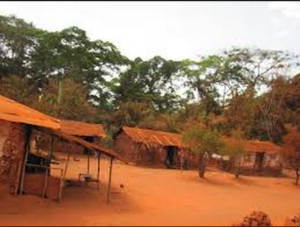The Maka tribe is found in the southern east of Cameroon precisely in the Haut- Nyong department between 12° 30 and 30°35 east longitude and in between the 3°35 and 4°35 northen latitude with an island localized between the 13°35 eastern longitude and the 4°45 northern latitude. They occupy 6000 Km2of the 106900 Km2hold by the eastern region starting from the Ayos Bridge going through Abombang, Doume, Nkolmedouga and Angosas. Also, they can be found in areas such as Mboma, Ngoab, Mayos, and Midou.
Terrain of land and relief
The Maka soil is predominantly ferrallitic, with a red color and very poor in nutritive elements. That soil is also gifted or rich in iron. The majority of the terrain of land is made up metamorphic rock such as mica, migmatite, granite, schist. The land is not very fertile because of leaching. Leaching on the other hand is caused by the humid environment. The Maka soil includes largely gently undulating hills. Those hills are known as “half oranges” because they resemble a lot to oranges. As earlier said, the forest dominates the Maka territory. Nevertheless, this vegetation may have served as a shelter to the Maka and the other eastern population in front of the various attacks of the Gbaya, Bulu-Beti-Fang. Nonetheless, the forest is less dense the more we get closer to the north and leaves the place to a wooded savanna. The Maka forest is composed of hardwood evergreens of species like ebony, obeche, sapelli and iroko. Some of those trees can grow above 70 meters. The forest is stratified into many levels. The first level is composed of thick-rooted trees measuring something like 40 meters tall. The following one includes thinner trees with highly placed clusters of leaves. Areas which are closer to settlements and roads are characterized by the presence of the largest trees. Thus, the forest floor is exposed to more direct sunlight and tick vegetation is allowed to thrive. Furthermore, the Maka area is renowned for its riches as far as the flora is concerned. What about the habitat?
Habitat
The traditional Maka house is a rectangular structure made of mud bricks held together by a bamboo frame. The A-shaped roof is covered in raffia palm leaves, though tin or aluminum roofing is today becoming more common. Wealthier Maka and those living in larger villages and towns often live in modern concrete-block houses, as well. Let’s have a look on the Maka climate.


What about the climate?
Climate
The Maka people are found in a forestry zone, thus the presence of these trees bring cool current of air. This usually makes the climate to be cold, most of the times. As in other forest zones, the Maka area has a wet equatorial climate and precisely the Guinea type climate. This type of climate is characterized by the lack of traditional seasons. Instead, there is a long dry season starting from December and ending in May; a wet dry season starting from May to June and a heavy wet season from October to November. The average temperature there is about 23C° and the annual amplitudes are very weak. Humidity and cloud are very high and the precipitation average is situated in between 1500-2000 mm per year. It is a predilection area for some activities such as hunting and gathering. What is the impact of this latter on their lifestyle?


Influences on lifestyle
The presence of too much vegetation and forest bring in wildlife and create habitats for animals such as rats, snakes especially vipers, porcupines, pangolin, monkeys and many others. This wildlife therefore gives to the Maka the instinct to hunt. They are known to be the best hunters compared to the rest of the Eastern tribes. They are greatly assisted in this practice by the Baka, commonly known as the pygmies. Also, they are bound to where long clothes because of the cold climate. In addition to this, they may where these long clothes for protection against harmful flies. It is the dense vegetation that brings these parasites to live near the human habitation.
Clothing
They dress according to the weather and climatic conditions. If it is cold or if they are going to the forest, then they wear thick and\or long clothes. If it is hot, then they wear light clothes. They dress in ordinary clothes, with the exception that they may wear some traditional clothing during a special occasion or when performing some rituals. Besides, it is important to mention that before the arrival of the Germans in that area, they used to dress just like the pygmies; in other words, they covered their private parts with leaves. Nowadays, with the modernization they dress like everyone but the unique difference is that they wear merely warming clothes because of the cold that they encounter there.
Food
The Maka who are known as being great hunters feed mainly by the animals they hunt.Traps are therefore the primary tool they used in spite of the fact that some firearms are employed nowadays in an increasing way. Thus, bush meat is an important source of income for many people there. In addition to that, the majority of the population is made up of subsistence farmers and the major crops of the area contain plantains, cassava, cocoyamand groundnut, various fruits raised in smaller quantities, cucumber, vegetables and maize. It is important to remind that their special dish or traditional dish there is “the Ndengue” which is a kind of banana mash which is eaten with vegetables. Also, livestock are animals such as pigs, chicken, goats and sheep.
The Maka area is gifted of forests which influence their lifestyle, clothing, food… What can be said about the social life, how are marriages and family life organized in the Maka territory?


No comments:
Post a Comment